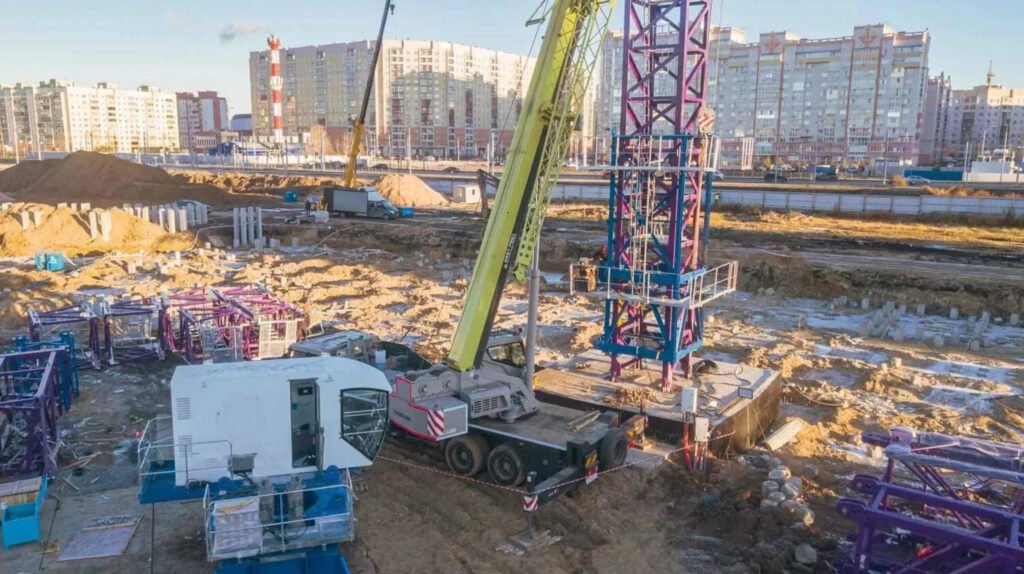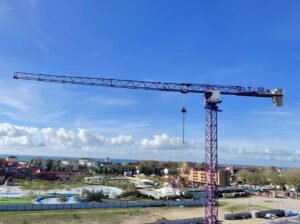How Is a Tower Crane Erected?
I’ve set up a lot of tower cranes in my day. Whether it’s for a high-rise or an industrial complex, the process requires precision, planning, and a keen understanding of the environment.
So, how do you set up a tower crane? In short, you start with preparing the site and laying a solid foundation, followed by assembling the mast, jib, and slewing unit with the help of a mobile crane. A climbing mechanism allows the crane to grow as the building rises, and final safety checks ensure it’s ready for operation.
But that’s just the surface—let’s dig deeper into the step-by-step process and what makes each phase so crucial. From site assessments to final testing, every part of this procedure demands attention to detail to guarantee safety and efficiency. Here’s how it all comes together.
4.Final Adjustments and Testing
5.Timeframe and Safety Considerations
Preparatory Steps
Site Assessment
Before any crane assembly begins, we first conduct a thorough site assessment. This is essential because the ground needs to be capable of supporting not only the weight of the tower crane but also the heavy loads it will lift during construction. Soil tests are crucial for determining whether the area has the necessary stability. Without this early step, there’s a significant risk of sinking or tilting later in the project. From my experience, this phase can often be overlooked, especially on tight schedules, but failing to properly assess the site can lead to costly delays down the line.
Foundation Construction
After the site passes all inspections, the next step is laying the foundation—the literal base on which the entire tower crane depends. At Vega Heavy, we always recommend using a solid concrete foundation, typically reinforced with steel rebar to enhance its strength. This foundation can weigh up to 400,000 pounds, depending on the crane’s size. The key here is allowing enough time for the concrete to cure properly. In one particular project, we allocated almost two weeks just for the foundation to settle, ensuring maximum stability. Skimping on this part will always cost more later when dealing with potential structural failures.
The Erection Process
With the foundation ready, the actual erection of the tower crane begins. Let me walk you through the steps that we follow at Vega Heavy to ensure everything runs smoothly.
Initial Assembly: Mobile Crane and Mast Installation
The first step in assembling the crane is bringing in a mobile crane. While the tower crane itself does the heavy lifting during the construction phase, we rely on a mobile crane to handle the initial setup. The mobile crane is responsible for placing and securing the base and the first few mast sections—these steel lattice structures give the crane its height and strength. Once the first few mast sections are in place, they are securely bolted together. This part of the process is delicate, as any misalignment in the mast could affect the entire crane’s stability.
Slewing Unit Installation
Once the mast is erected, we install the slewing unit. This component allows the tower crane to rotate 360 degrees, enabling it to move materials all around the construction site. The slewing unit is attached to the top of the mast, and its installation must be done with extreme precision. I’ve often seen clients underestimate how crucial this part is, but without it, the crane loses its ability to operate efficiently.
Jib and Counter-Jib Assembly
With the mast and slewing unit in place, the next step is attaching the jib and counter-jib. The jib is the crane’s main arm, responsible for carrying loads across the site, while the counter-jib balances the weight. Both these parts are connected to the slewing unit using steel tie rods, which help distribute the load evenly. I can’t emphasize enough how important it is to ensure proper balance here. Misalignment or insufficient counterweight could lead to instability when lifting heavy materials.
Climbing Mechanism: Increasing Height
One of the most fascinating aspects of tower cranes is their ability to climb as the building grows taller. This process involves using a special climbing frame that allows new mast sections to be inserted as the crane’s height needs to increase. To achieve this, the slewing unit is temporarily detached, raised using hydraulic rams, and then a new mast section is inserted. I’ve witnessed this process on several high-rise projects, and it always amazes clients to see the crane “grow” alongside the building. This ability makes tower cranes indispensable for large projects that require extended reach over time.
Final Adjustments and Testing
After the crane is fully assembled, the last but crucial step is the testing phase. At Vega Heavy, we ensure that every crane undergoes load testing to confirm that it can safely handle its maximum capacity. We also check the functionality of all safety features, such as the limit switches that prevent overloading, and the emergency stop mechanisms. I’ve seen situations where even a slight error in load capacity can lead to disastrous results, so this step is non-negotiable. In fact, a client once thanked us profusely after a successful final inspection saved them from what could have been a costly accident.
Timeframe and Safety Considerations
Erecting a tower crane typically takes anywhere from a few days to several weeks, depending on the size of the crane and the complexity of the project. Larger cranes, particularly those used for skyscrapers, can take more time due to their height and additional components. Throughout the process, safety is always our top priority. Wind loads must be constantly monitored, and every part of the crane must be securely fastened to prevent accidents. I’ve always found that clients appreciate how meticulous we are when it comes to safety, and this attention to detail has helped us build long-lasting relationships.
Conclusion
Erecting a tower crane is a detailed and complex process, but it’s one that can make or break a construction project. From soil testing and foundation preparation to mast assembly and final testing, each step is vital to ensuring that the crane operates safely and efficiently. At Vega Heavy, we pride ourselves on providing not just cranes, but peace of mind. We work closely with our clients to ensure every detail is taken care of, so they can focus on what matters—getting the job done on time and safely. Understanding the steps involved in erecting a tower crane will help you better manage your project and avoid common pitfalls that could lead to costly delays or safety issues.






